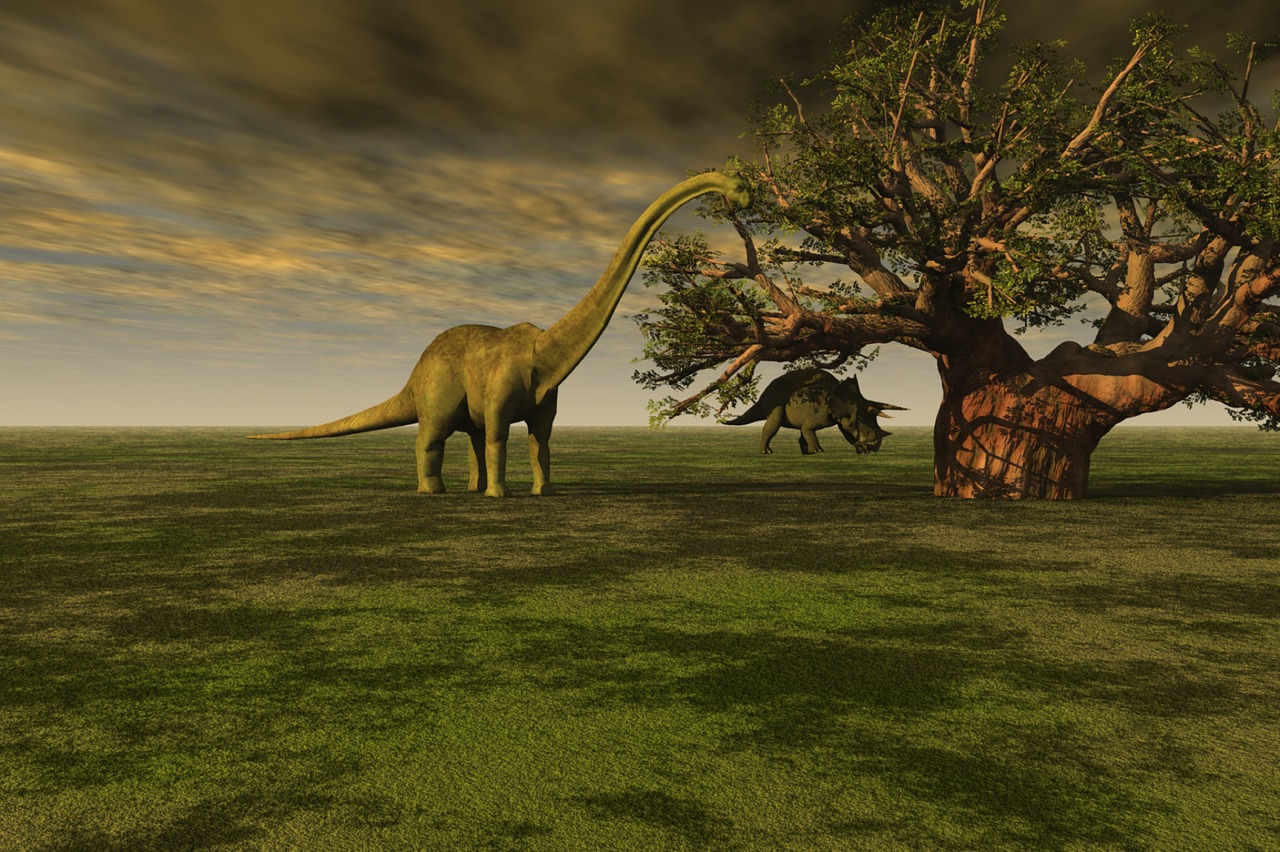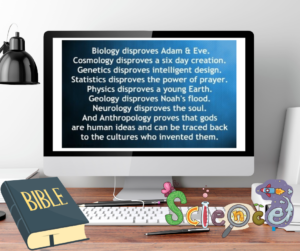Dinosaurs are fascinating creatures! Ever since childhood, I have been enthralled by these monstrous lizards who lived so long ago. My favorite dinosaur was and still is; the mighty T-Rex! Standing at an average height of 13 feet with jaws that look like they could crush anything, the Tyrannosaurus Rex was definitely a dinosaur that captivated my attention. Although I admire the Tyrannosaurus Rex, I certainly would never want to meet one in person!
Many creationists, however, insist that some humans HAVE personally met some of the dinosaurs. They say that dinosaurs and human beings lived alongside one another. This is because their view of the creation days in Genesis 1 and their counting of the genealogies bring them to conclude that the Earth is only 6,000 years old. Since land animals were made on day 6 (and many dinosaurs were land-dwellers) and humans not long after, they infer that they must have lived alongside each other for a time. I have written elsewhere that Genesis 1 and 2 are not incompatible with an old Earth and evolution in such blog posts as “The Cosmic Temple View Of Genesis One” and “Why There’s No Conflict Between Evolution and A Historical Adam”. However, I’m not going to dispute how to interpret Genesis in this article. Rather, I’m going to address some biblical arguments that young earth creationists (here on out, YECs) use in an attempt to prove from The Bible that dinosaurs lived alongside man.
The Leviathan and The Behemoth
The Bible makes occasional reference to two monstrous creatures; Leviathan and Behemoth. Isaiah 27:1 speaks of “Leviathan the fast-moving serpent, Leviathan the squirming serpent; . . . the sea monster” (NET) In Psalm 104:25–26 God is praised as the One who created the habitat for the leviathan: “There is the sea, vast and spacious, teeming with creatures beyond number—living things both large and small. There the ships go to and fro, and Leviathan, which you formed to frolic there.” In Psalm 74:14, the Psalmist says that God crushed the heads of Leviathan.
Job 40:15-20 mentions the Behemoth. God says to Job “Behold, Behemoth, which I made as I made you; he eats grass like an ox. Behold, his strength in his loins, and his power in the muscles of his belly. He makes his tail stiff like a cedar; the sinews of his thighs are knit together. His bones are tubes of bronze, his limbs like bars of iron He is the first of the works of God. Let him who made him bring near his sword! For the mountains yield food for him where all the wild beasts play.” (ESV)
What Exactly Is The Leviathan?
YECs argue that the Leviathan and Behemoth are dinosaurs. Certainly, the way these fierce creatures are described don’t fit the description of any known animals today.
In Episode 40 of The Naked Bible Podcast, Dr. Michael Heiser was asked about the Leviathan. This is what Michael Heiser said in that episode of The Naked Bible Podcast:
“You have this term tannin or taninim, … These things…. are mentioned in connection with several themes in the Old Testament. …. Genesis 1:21 is obviously a creation theme. Now before we even hit the language, we need to back up and think about Genesis 1. There are a number of scholars, it’s not so prevalent now as it was ….but because you have ….creation descriptions outside of Genesis 1 in the Bible that have God slaying a dragon or a sea monster, Psalm 74 is probably the best example here, because you have those scenes, that sort of triggered a whole way of approaching all creation texts in Genesis, at least one time. And the reason is this. In Psalm 74, the notion was look, here the God of Israel has slain this great sea beast, and that’s associated with creation language. ……. Since God is slaying this beast, and that is associated with the act of creation, this is just like certain Babylonian creation stories. The biggest example would be a Enuma Elish, where in the end, Marduk slays a great sea dragon and chops the carcass, splits it in half, and one half he makes the sea and the other half makes the dryland. So you’ve got this destruction of this beast and out of that comes the heavens and the earth. ….
Now the reason why you see that, not only in Babylonian material but also in lots of other material, is that the sea was otherworldly to an ancient near Eastern person. And it’s because it isn’t where people live. You can’t live on the sea. You can’t live in the sea. The sea is chaotic …..Now when you’re out at sea in a boat and you see big animals in it, whether whales and sharks or whatever it is, you tend to associate …these huge creatures … in this otherworldly place, They lend themselves to being portrayals of that place. And that’s why you have in the ancient near East a lot of this kind of symbology, great sea creatures that represent chaos. …. Well, Enuma Elish, the Babylonian story, again, since the supposition was, and you get this in biblical literature, you get it in Mesopotamian literature, you get it in Egyptian literature, that before there was any land to inhabit for human habitation, there was just water. And so the primeval mound rises up out of the water, either at the command of the god or is created by the god from some pre-existing material. In this case, it’s the carcass, at least half the carcass, of this great sea beast. So Marduk brings order out of chaos and creates dry land for human habitation.
…….So since scholars were familiar with these stories, when they would look up the passages like Psalm 74, they thought “well that’s really a good match for this whole idea” and then they’d go back to Genesis 1 and ask, “Well, is this stuff in Genesis 1?” And … you get really two things. You get Genesis 1:21, the reference to the taninim, and you also get the word tehom, which is in most English translations translated the deep. Now tehom, again, a few decades ago, this was accepted as a coherent argument. …. But tehom was thought to be the Hebrew equivalent of tiamot, which was the name of the sea dragon in the Babylonian Enuma Elish story. ….The supposition was tehom and taninim, there is no battle going on in Genesis 1. ….What Genesis 1 is trying to convey is that when the God of Israel, who’s the real creator, started doing his thing, these forces were already held in check. ….They were submissive and bound and so it was a theological polemic. …. Now, of course, it doesn’t work in Psalm 74, but, again, this was the thinking.” 1
Dr. Heiser went on to say that in the current era of scholarship, they see Leviathan somewhat different, though not drastically. Heiser says that a bunch of Ugaritic material was discovered in 1929 which caused scholarship from being Babylonian focused when talking about Genesis to being Ugaritically focused. As a result, nowadays Ancient Near Eastern scholars don’t see the Babylonian creation epic in Psalm 74, but they see an Ugaritic story. Why? Well, because of the use of the same terms. You have the terms “tanum” or “tanuna” which is the same thing as the “taninim”, also present are the terms “lotan” or “livyatan”. This is the same as Leviathan in Old Testament scripture passages. Heiser goes on to point out that the Ugaritic story containing “tanum”, and livyatan” in the Ugartitic narrative don’t have creation as its subject. 2
So then, what is this crushing of Leviathan in Psalm 74 all about? It’s about who wears the pants in the Divine Council. It’s about who wears the pants in the pantheon. I can hear my readers groaning at this pun now. Anyway, in Episode 40 of The Naked Bible Podcast, Dr. Michael Heiser went on to explain that in the Babylonian story (particularly the tidbit about The Baal Cycle), you read that Baal ends up becoming the king of the castle. While he’s still under the authority of El, he is chosen by El to co-rule with him over and above all other deities. The text tells us that Baal accomplishes this by battling Letanu, winning the battle, and then killing Letanu. He then stands over Letanu’s body and says “Asta la vista, baby!” Ok, I may have taken some poetic license with that last part. Now, given the very close similarity in terminology, Heiser says, scholars concluded that the match was close enough to consider The Old Testament’s Psalm 74 as parallel to this Baal Cycle story rather than the Babylonian Marduk story. They took another gander at Genesis 1 and were like “Now that I think about it, I don’t think this is a polemic against Babylon. I think it’s a Polemic against the Canaanite religious views. This is spitting in the eye of their god Baal!”3
Whether one takes Psalm 74 as a polemic against Marduk being the destroyer of chaos as in the Enuma Elish or as being a polemic against The Baal Cycle, the point I wanted to make in heavily citing Dr. Michael Heiser is that the Leviathan was a symbol of chaos. It represented the sea. The sea was a symbol of chaos in the ancient world. This is not a dinosaur. This is a mythological creature the authors of scripture are making use of to declare the supremacy of Yahweh. Marduk is not the slayer of the chaos dragon. Yahweh is. Baal isn’t the one who brings order to the cosmos. Yahweh is. Yahweh is supreme. Yahweh is the head of The Divine Council.4
What About Behemoth?
I watched a video on this recently by biblical YouTuber Ben S. Ben S made a video called “Why Behemoth Isn’t A Dinosaur”.
In his video, Ben S. said: “The Hebrew word Behemoth is etymologically derived from the run of the mill Hebrew word for frequently used for cattle: Behema.”5
Ben S. went on to say “Bernard F. Batto, a Hebraist scholar at DePaul University who has specialized in the Ancient Near Eastern context of Behemoth has pointed out that if anything, linguistically the connotation suggests that this is a sort of ‘super ox'”6
There is nothing in Job 40 that gives reptilian descriptive features of Behemoth. However, we would expect reptilian descriptive features if Behemoth were something like a Brachiosaurus or other dinosaur.
Ben S says that the most notable feature about the Brachiosaurus is its massively long neck. The neck of a Brachiosaurus in 18 meters in height. Wouldn’t we expect God to emphasize that instead of the mundane line in Job 40:15 that he feeds on grass like an ox? Not exactly something that impressive. Ben S. points out that expecting the author of Job (and God Himself since he’s the one speaking in the passage) to omit the 18 meters of the neck seems as absurd as for someone to brag about a giraffe’s features without mentioning its long neck.
What about Job 40:17’s line about the Behemoth extending its tail like a cedar? I don’t always laugh when watching YouTube videos on biblical Hebrew, but when I do, it’s because my inner child came out. And why did my inner child come out? Because what this text is about is…..Behemoth’s balls. No, Behemoth doesn’t play sports. I’m talking about testicles. Ben S. says that Behemoth’s tail “is much more likely to be a cultural euphemism for his male appendage. That explanation may not preach as well on a Sunday morning, but it isn’t some kind of new liberalization by pointy-headed academics. It’s very old and is recognized in most academic commentaries and is firmly supported by the lexical evidence.” 7
Job 40:16-18 uses parallelism when describing Behemoth’s body. Hebraic Parallelism was a technique Hebrew writers would use. The way it worked is that the writer would talk about X in one line, and then they would talk about something in the very next line that echoed features of X in the previous line.
“Behold, his strength in his loins,
and his power in the muscles of his belly.
He makes his tail stiff like a cedar;
the sinews of his thighs are knit together.
His bones are tubes of bronze,
his limbs like bars of iron.” (ESV)
Ben S then tells his YouTube audience to consider the following 4 points.
1: The Cuplet Parallelism Anticipates A Synonym For The testicles In The Place Where You See “Tail”.
In the structure of this Bible verse, the tail is parallel to the Hebrew word pachad. There’s only one time that the Hebrew word pachad is ever used in the entire word of God and it’s right here in this Job passage. Have no fear though, we can still know what Pachad means by looking outside The Bible. There’s an extremely similar word in the Aramaic language. The word literally means “thighs”, but the Aramaic cognate has testicular connotations when it is used in extra-biblical writings. Ben S. says that this is why ancient Jewish scholars like Rashi and even Ezra interpreted it as the testicles.8 Moreover, as early as Jerome in the 4th century, we find the Latin word “testiculorum” used in the Latin Vulgate. Jerome did this to help get the nutty allusion across. Get it? Nutty? Nuts? Sorry.
2: The Verb In Its Surrounding Context Supports A Reproductive Euphemism.
In “The Journal For The Study Of The Old Testament”, David Burnett has an article in which he says that it makes sense to think of reproductive euphemism being what the verb related to Behemoth’s tail is about.9 He says it denotes a double meaning. The word translated “extends” usually means extends but can also connote such meanings as delight such as in Psalm 51:6, Genesis 49:3, Deuteronomy 21:17, and Psalm 105:36. Taking Behemoth’s tail as a euphemism for its nuts simultaneously employs both of these meanings.
3: Connotation of “Strength Is In His Loins” Is Consistent With Reproductive Euphemism
In his journal article, David Burnett says “Strength is in his loins” also refers to reproductive virility in other passages. Burnett cites Genesis 49:3, Deuteronomy 21:17, and Psalm 105:36 as examples of this.
4: Post-Biblical Usage Supports This.
— See Ben S’ video.
How Other Ancient Near Eastern Texts See Behemoth.
The nearby kingdom of Ugarit had a language and culture that was very similar to Israel, so most ANE scholars such as John Walton and Michael Heiser would say that the Ugaritic texts are the most beneficial to compare the Old Testament books with. By doing this, we can dig into the cultural cognitive environment. Compare Job 40 and 41 to the following:
“Surely I lifted up the Dragon.
I destroyed the twisting Serpent,
The Tyrant with the seven heads
I destroyed Arshu, beloved of El,
I put an end to El’s calf Attik.”10
Just like in Job, “The calf of Attik” (a bull deity), is paired with a “twisting serpent with seven heads,” which parallels the Biblical Leviathan. Fertility idols were often depicted as cow-like in the Ancient Near East.
The Epic of Gilgamesh, in the poem “Gilgamesh and The Bull Of Heaven” says this; “Lord Gilgamec ……. Inana …… the Bull of Heaven. At Unug, the Bull ……, and drank the water of the river in great slurps. With each slurp, it used up one mile of the river, but its thirst was not satisfied. It devoured the pasture and stripped the land bare.”11
In this passage from Gilgamesh, a number of lines are missing, but we can see that the text evidently mentions a Bull who is thirsty as frick! This bull drinks up one mile of the river with each thirst. Yet with all that river water, the bull’s thirst still wasn’t satisfied. I’d hate to be around when that thing finally had to pee! What’s noteworthy here is that this unfathomable thirstiness of Gilgamesh’s bull is how Job describes Behemoth! Job 40:23 says “Behold, he drinketh up a river, and hasteth not: he trusteth that he can draw up Jordan into his mouth.” (KJV) Behemoth drinks river water like Gilgamesh’s bull.
Conclusion
Leviathan was a mythical creature symbolizing chaos and Behemoth is a divine fertility god of massive power and size. At this point, readers might be wondering “Why would God reference two pagan deities in His final speech to Job?” And furthermore, why would God positively speak of this pagan deity? “Behold now behemoth, which I made with thee…He is the chief of the ways of God: he that made him can make his sword to approach unto him” (verses 15, 19 KJV). As Phil Cottraux of the blog “Depths Of Pentecost” points out;
“An important principle to remember is that God meets people where they are in history and speaks to them in a language they’ll understand. At this point He’s explaining His mastery over creation. Job certainly would have been familiar what Behemoth symbolized to neighboring kingdoms: the unfathomable wonders of the animal world. In the previous chapter, God had listed goats, oxen, peacocks, grasshoppers, and eagles. Then in chapter 40, he uses the Behemoth as a symbolic summary to demonstrate that He rules over what man cannot tame.
This kind of poetic symbolism is common in ancient texts and is crucial to properly interpret early Biblical writings.”12
Neither Leviathan nor Behemoth are dinosaurs. YECs who assert that they are show an ignorance of Ancient Near Eastern scholarship.
NOTES
1: The Naked Bible Podcast, “Episode 40: Q&A 1”, Michael S. Heiser, and Trey Strickland, page 6 of the transcript– https://nakedbiblepodcast.com/wp-content/uploads/2015/03/Transcript-40-QA1.pdf
2: The Naked Bible Podcast, “Episode 40: Q&A 1”, Michael S. Heiser, and Trey Strickland, page 7 of the transcript– https://nakedbiblepodcast.com/wp-content/uploads/2015/03/Transcript-40-QA1.pdf
3: ibid, page 8.
4: See my Blog Post “What Is The Divine Council and Is It Biblical?” — https://cerebralfaith.net/what-is-the-divine-council-and-is-it-biblical/
5: Ben S, “Why Behemoth Isn’t A Dinosaur”, November 2nd 2017, — https://www.youtube.com/watch?v=AxGARM5cYKY&list=WL&index=81&t=0s
6: Ben S, “Why Behemoth Isn’t A Dinosaur”, November 2nd 2017, — https://www.youtube.com/watch?v=AxGARM5cYKY&list=WL&index=81&t=0s
7: Ben S, “Why Behemoth Isn’t A Dinosaur”, November 2nd 2017, — https://www.youtube.com/watch?v=AxGARM5cYKY&list=WL&index=81&t=0s
8: Bernat, “Biblical Waṣfs,” 336.
9: Bernat, “Biblical Waṣfs,” 226.
10: As quoted in http://depthsofpentecost.com/blog/no-dinosaurs-arent-in-the-bible-part-1
Share this:
- Click to share on Facebook (Opens in new window) Facebook
- Click to share on X (Opens in new window) X
- Click to print (Opens in new window) Print
- Click to email a link to a friend (Opens in new window) Email
- Click to share on Pinterest (Opens in new window) Pinterest
- Click to share on Reddit (Opens in new window) Reddit
- Click to share on LinkedIn (Opens in new window) LinkedIn
- Click to share on Tumblr (Opens in new window) Tumblr
Discover more from Cerebral Faith
Subscribe to get the latest posts sent to your email.





An objection some creationists may have is that if the Leviathan and Behemoth were not literal creatures but symbols of chaos, wouldn’t it be like God telling someone today he can control Godzilla or King Kong? Since these creatures do not really exist,they maintain,how would Job be awed by God’s greatness?
Because Job and his contemporaries believed they did exist. This is just one of a plethora of examples throughout The Old Testament in which God sets himself up as superior to pagan gods by saying that He defeated the creatures these other cultures said their gods defeated. It’s (1) polemical and (2) another example of God accommodating His message to the cultural beliefs of that time.
With these popular interpretations not fitting the text very well, we should look at the Ancient Near East’s literature to get a better picture of the identity of these monsters. We must look at their world and not our own to understand what the author of Job most likely believed and the message that he was conveying. We should not use our own standards or presuppositions to judge the identity of these creatures. Thus, let’s look at the world of ancient literature to understand these creatures. With this in mind, we can use the Ancient Near East context to state that the hippopotamus and crocodile are